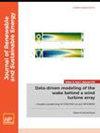与风能和太阳能联合运行的混合 CAES 系统的性能分析和调度研究
IF 1.9
4区 工程技术
Q4 ENERGY & FUELS
引用次数: 0
摘要
混合压缩空气储能(H-CAES)系统可有效减少压缩过程中的热损失,是解决可再生能源波动问题的重要方法之一。本文以绝热压缩和等温压缩相结合的 H-CAES 系统为基础,提出了适应输入功率波动的液体活塞压缩机布置方式,并提出了解决 H-CAES 系统中绝热压缩和等温压缩的功率分配计算方法,重点分析了可再生能源的参与对系统性能的影响。此外,将 H-CAES 系统置于风光储条件下,针对不同场景提出了以分时电价为判断依据的调度策略,以探讨 H-CAES 系统的实际运行效果。结果表明,将液体活塞压缩机的布置方式由组数较少的大罐改为组数较多的小罐,可以更好地适应功率变化,同时保持较好的等温压缩效果。在使用本文提出的功率分配计算方法的基础上,发现较高的压缩机出口压力和较低的储气压力可以提高系统效率和经济效益。在压缩机出口压力为 4 MPa 时,系统效率可达 59.71%,年投资回报率为 0.2261。最后证明,H-CAES 与风能联合运行可起到增加电厂运营收入的作用,最高可实现日发电收入 8909.236 元。本文章由计算机程序翻译,如有差异,请以英文原文为准。
Performance analysis and scheduling study of hybrid CAES system operating jointly with wind and solar
Hybrid compressed air energy storage (H-CAES) system can effectively reduce the heat loss in the compression process, which is one of the important methods to solve the problem of renewable energy volatility. Based on the H-CAES system that combines adiabatic compression and isothermal compression, this paper proposes a liquid piston compressor arrangement to adapt to the input power fluctuation and proposes a power allocation calculation method to solve the adiabatic compression and isothermal compression in the H-CAES system, with an emphasis on analyzing the impact of the participation of renewable energy sources on the system performance. In addition, the H-CAES system is placed under wind-solar-storage conditions, and scheduling strategies judged by time-sharing electricity price are proposed for different scenarios to explore the actual operating effects of the H-CAES system. The results show that the arrangement of liquid piston compressors from large tanks with fewer groups to small tanks with more groups can better adapt to the power change while maintaining a better isothermal compression effect. On the basis of using the power allocation calculation method proposed in this paper, it is found that higher compressor outlet pressure and lower storage pressure can improve the system efficiency and economic benefits. The system is able to achieve 59.71% efficiency and 0.2261 annual return on investment at the compressor outlet pressure of 4 MPa. Finally, it is demonstrated that the combined operation of H-CAES and wind energy can serve to increase the operating income of the power plant, and a maximum of 8909.236 yuan in daily electricity generation revenue can be achieved.
求助全文
通过发布文献求助,成功后即可免费获取论文全文。
去求助
来源期刊

Journal of Renewable and Sustainable Energy
ENERGY & FUELS-ENERGY & FUELS
CiteScore
4.30
自引率
12.00%
发文量
122
审稿时长
4.2 months
期刊介绍:
The Journal of Renewable and Sustainable Energy (JRSE) is an interdisciplinary, peer-reviewed journal covering all areas of renewable and sustainable energy relevant to the physical science and engineering communities. The interdisciplinary approach of the publication ensures that the editors draw from researchers worldwide in a diverse range of fields.
Topics covered include:
Renewable energy economics and policy
Renewable energy resource assessment
Solar energy: photovoltaics, solar thermal energy, solar energy for fuels
Wind energy: wind farms, rotors and blades, on- and offshore wind conditions, aerodynamics, fluid dynamics
Bioenergy: biofuels, biomass conversion, artificial photosynthesis
Distributed energy generation: rooftop PV, distributed fuel cells, distributed wind, micro-hydrogen power generation
Power distribution & systems modeling: power electronics and controls, smart grid
Energy efficient buildings: smart windows, PV, wind, power management
Energy conversion: flexoelectric, piezoelectric, thermoelectric, other technologies
Energy storage: batteries, supercapacitors, hydrogen storage, other fuels
Fuel cells: proton exchange membrane cells, solid oxide cells, hybrid fuel cells, other
Marine and hydroelectric energy: dams, tides, waves, other
Transportation: alternative vehicle technologies, plug-in technologies, other
Geothermal energy
 求助内容:
求助内容: 应助结果提醒方式:
应助结果提醒方式:


